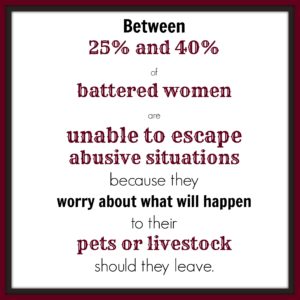Tougher Laws for Animal Abuse in Arizona – SB 1295
Share

It appears that every dog (and every other species of animal) will finally have their day — in court, that is. Arizona animal abusers are now facing harsher penalties thanks to a new anti-cruelty law called SB 1295, that goes into effect on August 7, 2019.
Prior to SB 1295, the toughest penalty for animal abuse was a Class 6 felony. This was often pleaded down to a misdemeanor, which meant even the most extreme cases of animal abuse received little more than a slap on the wrist.
Prosecutors now have the ability to charge abusers with a Class 5 felony. In addition to harsher penalties, the law also requires abusers to receive supervised probation and treatment (a condition that was often overlooked in previous legislation).
In the SB 1295 bill, a domestic animal is defined as, “a mammal that is kept primarily as a pet or companion or that is bred to be a pet or companion.”
SB 1295 makes it a class 5 felony to:
- Intentionally or knowingly subject a domestic animal to cruel mistreatment. (To torture, inflict unnecessary serious physical injury or kill the animal in a manner than causes protracted suffering.)
- Intentionally or knowingly kill a domestic animal without either legal privilege or consent of the domestic animal’s owner or handler.
Animal Abuse is Now a Class 5 Felony
This small change in state law reclassifies the most heinous animal abuse from a Felony 6 (the lowest level) to a Felony 5 and gives prosecutors more tools.
Sentences for Felony 5’s often include supervised probation and required counseling compared to Felony 6’s – a common-sense approach that could make a big difference in our community.
“Every day, our emergency animal rescue and cruelty team and trauma hospital see horrific cases of animal cruelty, said Steven Hansen, DVM, Arizona Humane Society President and CEO. “Our current laws must be stronger, and penalties greater. Prosecutors need the right tools to ensure the punishment fits the crime.
Anyone who works with animals or people will tell you that animal abuse is part of a much larger pattern of domestic violence, and a legitimate indicator of criminal behavior, which expands to serial killers and mass shooters
The FBI and it’s Stance on Animal Cruelty
The FBI recognizes the connection between animal abuse and human abuse and now collects data on animal abuse.
Research has shown consistent patterns of animal cruelty among perpetrators of other forms of violence, including child, spousal and elder abuse.
Acts of cruelty against animals are now considered felony crimes like arson, burglary, assault, and homicide.
In 2016, the Bureau’s National Incident-Based Reporting System (NIBRS) began collecting detailed data from participating law enforcement agencies on acts of animal cruelty, including gross neglect, torture, organized abuse, and sexual abuse.
Prior to 2016, crimes that involved animals were dumped into an “All Other Offenses” category in the FBI’s Uniform Crime Reporting (UCR) Program’s annual Crime in the United States report, a survey of crime data provided by about 18,000 city, county, state, tribal, and federal law enforcement agencies.
The National Sheriffs’ Association was a leading advocate for adding animal cruelty as a data set in the Bureau’s collection of crime statistics. The association for years has cited studies linking animal abuse and other types of crimes—most famously, murders committed by serial killers like Ted Bundy, Jeffrey Dahmer, and the “Son of Sam” killer David Berkowitz. The organization also points out the overlap animal abuse has with domestic violence and child abuse.
“If somebody is harming an animal, there is a good chance they also are hurting a human,” said John Thompson, deputy executive director of the National Sheriffs’ Association. “If we see patterns of animal abuse, the odds are that something else is going on.”
“I look forward to changes in our criminal laws that will allow us to meet community expectations in punishing this vicious type of behavior.”
-Maricopa County Attorney Bill Montgomery
Increasing penalties for heinous cases of pet abuse gives prosecutors a crucial tool to ensure that the sentence reflects the severity of the crime. Senate Bill 1295 ensures that the most violent abusers would be facing a Class 5 felony.
Facts About Animal Cruelty
Some interesting facts about animal cruelty and its relation to crime, according to The Link Monograph.
- Animal abuse is more prevalent in homes that experience child abuse and domestic violence. (Ascione & Shapiro, 2009; Ascione, 2007)
- Animal cruelty is included as one of the symptoms of “conduct disorder”. (American Psychiatric Association, 2013)
- Family pets may be targets of threats, harm, or killing to “emotionally blackmail” and coerce human victims to comply with and remain silent about abuse (Arkow, 2014)
- Family members who suffer domestic violence may be more likely to remain in an abusive home, or return home, if they do not have a safe place to put their pet. When children witness violence in the home, they are at increased risk of displaying violence toward animals. (Currie, 2006)
- Children often have an emotional bond with their pets, and may suffer psychological harm if that pet is threatened, harmed, or killed.
- 43% of school shooters have animal abuse in their background. (Arluke & Madfis, 2013)
- Animal hoarding is a mental health issue that must be treated in order to avoid continuing abuses. Hoarding impacts the social, emotional, and physical development of children in the home, and contributes to a public health issue. (Patronek, 2006, 2008)
- Bestiality is connected to crimes against people. (Hensley, Tallichet & Singer, 2006; Simons, Wurtele & Durham, 2008)

Facts About Animal Abuse & Domestic Violence
We’ve discussed a lot about the connections between domestic violence and animal abuse, along with the reluctance of women to leave when there are pets and livestock involved.
This is one more reason why it’s so important to support women shelters that allow animals.
- 1.3 million women and 835,000 men in the U.S. are victims of physical assault by an intimate partner each year (National Coalition Against Domestic Violence, 2007)
- Twelve independent studies report that between 18% and 48% of battered women have delayed their decision to leave their batterer, or have returned to their batterer, out of fear for the welfare of their pets or livestock. (Ascione, 2007)
- A 2012 study found that 59% of abused women delayed leaving the home out of fear of leaving their pets behind. (Alberta SPCA, 2012)
- In a study of domestic violence shelters across the country, 85% of shelter directors encountered cases in which women disclosed animal abuse. (Ascione, Weber & Wood, 1997)
- A 2007 study found that women seeking refuge at a family violence shelter were nearly 11 times more likely to report that their partner had hurt/killed their pet and that shelter women were 4 times more likely to report that their pet had been threatened. (Ascione et al., 2007; Volant, Johnson, Gullone & Coleman, 2008)
- In a study of battered women in several northeastern states, 48% of respondents reported that animal abuse had occurred “often” during the past 12 months, and another 30% reported that the abuse occurred “almost always.” Types of animal abuse reported included punching, hitting, choking, drowning, shooting, stabbing, and throwing the animal against a wall or down stairs. Respondents reported that animal cruelty incidents coincided with violent outbursts against human family members 51% of the time. (Carlisle-Frank, Frank & Nielsen, 2006)
- “Batterers who also abuse their pets are both more controlling and use more dangerous forms of violence [sexual violence, marital rape, emotional violence and stalking] than batterers who do not”. (Simmons & Lehmann, 2007)
- In a study of the barriers preventing rural women from leaving domestic violence abusers, Canadian researchers identified animal abuse, social and geographic isolation, poverty, a lack of social services, inadequate transportation, and firearms as factors that silence women from leaving or reporting.
- “Pets and/or farm animals are often threatened, harmed or neglected as a means of controlling an abused woman, and it is common for women to delay seeking help out of fear for their animals.”
- Forty-five percent of the women said that their pets and/or farm animals were deliberately threatened with harm, and in 41% of cases the pets actually were deliberately harmed or killed. (Doherty & Hornosty, 2008)
- One of the strongest studies covered a seven-year period in 11 different site locations to look at factors that initiate battering behavior. While the study did not set out to focus on animal abuse, the results showed that animal abuse was a significant variable and was one of only four factors associated with becoming a batterer. (Walton-Moss, et al., 2005)

References:
- AZ HB2421 | 2019 | Fifty-fourth Legislature 1st Regular. (2019, March 22). LegiScan. Retrieved August 27, 2019, from https://legiscan.com/AZ/bill/HB2421/2019 https://cops.usdoj.gov/html/dispatch/04-2019/animal_cruelty.html
- 1.Mark Griffiths, “The Psychology of Animal Torture,” In Excess [blog], Nov 23, 2016, Psychology Today, https://www.psychologytoday.com/us/blog/in-excess/201611/the-psychology-animal-torture.


